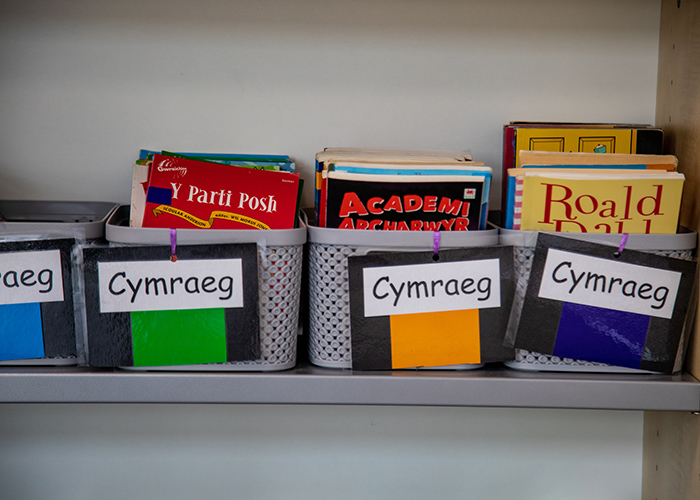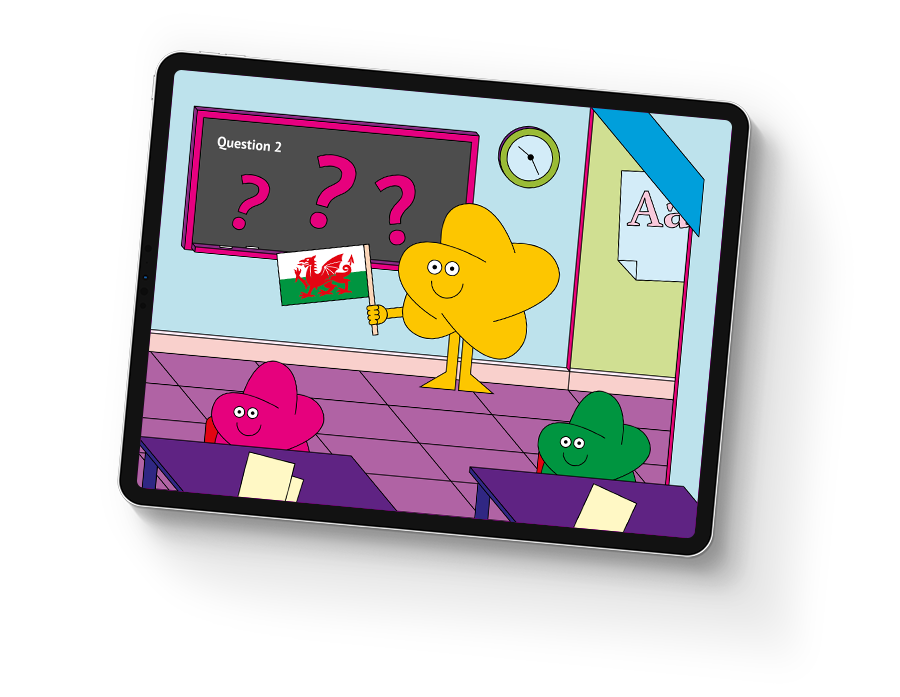Key Themes
The Welsh language in education and training
2022-2023

During 2022-2023, our inspection findings showed an inconsistent picture in terms of the Welsh language. The influence of the pandemic period continued to have a negative effect on the ability of learners to use the Welsh language. In the 2021-2022 annual report, we identified the impact of the pandemic on learners’ confidence in using the Welsh language in Welsh-medium, bilingual and English-medium schools. In 2022-2023, we found that many learners were making consistent progress in their Welsh skills, particularly in their listening and speaking skills in Welsh-medium settings. This was often the result of work done by providers to target learners’ oracy skills. However, pupils often did not make as much progress as they could in developing their Welsh overall, particularly in English-medium schools. Often, leaders in these schools did not prioritise the development of pupils’ Welsh language skills well enough. As a result, in those schools and in a majority of providers across sectors, learners’ Welsh skills were not developing strongly enough.
The development of pupils’ ability to communicate in Welsh in English-medium schools has been a cause for concern over a long period of time. In 2012-2013, Ann Keane, the chief inspector at the time, noted that inspectors made a recommendation to improve pupils’ Welsh skills in a quarter of the English-medium schools that were inspected (Estyn, 2013, p.26). A decade later, this continues to be the case. In 2022-2023, 30% of the English-medium primary schools and 18% of the Welsh-medium primary schools inspected received a recommendation on the Welsh language. A quarter of the secondary schools inspected in 2022-2023 received a recommendation relating to the Welsh language.
In December 2022, the Welsh Government (2022a) published the results of the 2021 Census on the Welsh language skills of people aged three or above who live in Wales. Between 2011 and 2021 there was a decrease of six percentage points in children aged between 5 and 15 who were reported as being able to speak Welsh (2022a, p. 5). Education and training providers face many challenges in developing the Welsh language skills of learners, including:
- Recruiting staff to teach through the medium of Welsh across the sectors. For example, in 2020-2021 the numbers completing their initial teacher education programme through the medium of Welsh were far below the targets introduced by the Welsh Government. Recruitment problems affect many sectors, including the secondary sector, with the numbers training to teach in some specialist subjects being very low. The recruitment of practitioners with the necessary specialist skills to support pupils with additional learning needs was also a cause for concern.
- Ensuring suitable and flexible professional learning to support practitioners to develop their personal Welsh language skills.
- Ensuring suitable professional learning to support practitioners to develop their understanding of how learners acquire language and the most effective pedagogy to support learners.
- Effective transition arrangements from one phase to another, for example between primary and secondary schools and on to post-16 education.
- Ensuring provision to meet the needs of post-16 learners, including opportunities to apply their Welsh language skills.
- Ensuring that leaders in English-medium providers place a priority on developing their learners’ Welsh language skills and understand the value of those skills for future employment.
During 2022-2023, the Welsh Government published several plans to support the Welsh language, including the Welsh in education workforce plan (Welsh Government, 2022b) and a consultation document on proposals for a Welsh Language Education Bill (Welsh Government, 2023a). These documents recognised the significant challenges in growing an education workforce with the necessary language skills to expand Welsh-medium education and improve the linguistic outcomes of pupils in all schools. The Welsh Government has identified the need to continue to increase the number of pupils who are educated through the medium of Welsh. It recognises that provision needs to improve and that contact with the Welsh language across all schools is important so that pupils have enough opportunity to develop their language skills and make sufficient progress.
According to Welsh Government statistics, in January 2023, there were 378 Welsh-medium schools, 27 dual stream schools, two schools that were in the transition process and 32 bilingual schools from a total of 1,463 schools in Wales (Welsh Government, 2023b). There were also 35 English-medium schools where significant use was made of the Welsh language. Since 2018-2019, the proportion of schools that provide education through the medium of Welsh has remained consistent at 30% of the total number of schools in Wales. In addition, the proportion of pupils in schools where at least half of the subjects are available through the medium of Welsh has remained consistent at 23%. The percentage of pupils taught in designated Welsh-medium schools has increased from 16% in 2012-2013 to 17% in 2022-2023 (Welsh Government, 2023b).
Where the support and enthusiasm to develop learners’ Welsh language skills was robust, leaders prioritised the Welsh language and set a clear vision and a strategic and purposeful improvement plan to develop provision. In settings with the most effective practice, leaders provided valuable professional learning opportunities and support for practitioners to develop their skills to support learners to acquire the Welsh language constructively over time. This fostered enthusiasm and confidence among practitioners, which had a positive effect on learners’ readiness to speak and use the Welsh language spontaneously in a variety of situations. For example, schemes such as the Welsh Language Sabbatical Scheme played a key role in developing practitioners’ Welsh language skills and their ability to teach through the medium of Welsh in some schools and clusters (Welsh Government, 2021a). In the best examples, we saw the effect of provision not only on individual teachers, but on how they used what they had learned to influence others. Most importantly, this had a positive effect on the teaching and standards of Welsh in these schools. Read about how St David’s R.C. Primary School, Cwmbran developed the Welsh language supported by purposeful professional learning.
In settings with less effective practice, leaders did not prioritise the Welsh language or promote the benefits of being bilingual and multilingual sufficiently. Often, they did not properly consider pupils’ progress or provision for the Welsh language when self- evaluating and planning for improvement. Too often, they considered that using a very few Welsh greetings and words with pupils was sufficient and there was no plan to develop Welsh language provision beyond a few specific lessons. In addition, very little professional learning was provided to help staff develop their skills and confidence in using the Welsh language with pupils. It is a cause for concern that this situation has continued in some schools over a long period of time.
The Welsh Government has provided a resource to help leaders develop Welsh in their schools. However, it is not clear how many leaders are aware of this resource or use it when self-evaluating their journey to develop the use of Welsh.
In line with the Guidance on Welsh in Education Strategic Plans (Welsh Government, 2021b) all local authorities have submitted a 10-year plan aiming to make ‘every learner one in a million’ and help achieve the ambition of having one million Welsh speakers in Wales. Although strategic plans have been introduced by local authorities, it is too soon to gauge the effect of these plans on leadership in providers across the sectors, or the impact on teaching and learning. In November 2021, the Welsh Government announced an investment of £2.2 million to support local authorities to develop their late immersion provision. This funding has enabled all local authorities across Wales to build on their existing provision or establish new late immersion provision (Welsh Government, 2021c).

Key messages from the sectors
In non-maintained settings, a majority of children who were new to the language in both Welsh and English-medium providers made progress in line with their stage of development. Practitioners ensured that pupils had opportunities to listen to, and use the language, for example by introducing simple Welsh instructions and songs. Children demonstrated their understanding by following instructions successfully. Children often used some English vocabulary when trying to communicate, for example when responding by saying ‘Dw i’n gallu torri banana by myself’ while preparing a snack. However, in a very few Welsh and English-medium providers, practitioners did not plan the next step in pupils’ Welsh language development effectively enough as they acquire the language.
As children moved to the primary sector, many pupils in Welsh-medium and bilingual schools, including those who were new to the language, made sound progress. In the best practice, practitioners planned pupils’ language development effectively in an interesting range of contexts across the areas of learning and experience. By doing so, pupils developed vocabulary and language patterns that supported their confidence to speak and use the Welsh language with increasing independence in formal and less formal situations. The reading and writing skills of many pupils were developed appropriately by practitioners as they provided valuable opportunities for pupils to apply them in various contexts.
In the secondary sector, in most Welsh-medium and bilingual schools, pupils expressed themselves appropriately using a wide range of vocabulary. However, a minority of pupils expressed themselves more awkwardly. Often in these cases, pupils’ vocabulary was more limited, they used incorrect sentence structure or slang, or their sentences often included too many English words. Overall, many pupils located facts and gathered information from reading texts successfully. Pupils could combine information from various texts appropriately. A majority of pupils wrote appropriately in Welsh with a few writing particularly effectively using sophisticated vocabulary and well-crafted sentences and paragraphs. However, a minority of pupils’ writing contained errors; they spelt words incorrectly or used awkward sentence structure.
Across most providers in the non-maintained, primary, secondary and all-age Welsh-medium and bilingual sectors, provision for developing pupils’ Welsh language skills was appropriate. In a minority of schools where we saw effective practice, settings provided professional learning opportunities to help practitioners deepen their understanding of pupils’ language development over time. As a result, practitioners planned the development of the Welsh language purposefully and provided valuable opportunities for pupils to speak and use the Welsh language in interesting and meaningful activities. This led to pupils making strong progress in their Welsh language skills. Read more about how Ysgol Caer Elen developed and promoted the Welsh language across the school.
.embed-container { position: relative; padding-bottom: 56.25%; height: 0; overflow: hidden; max-width: 100%; } .embed-container iframe, .embed-container object, .embed-container embed { position: absolute; top: 0; left: 0; width: 100%; height: 100%; }
Overall, when given an opportunity to do so, many pupils had a positive attitude to learning the Welsh language and were keen to learn about their local area, Wales and further afield. Read how leaders and practitioners at Ysgol Penclawdd focused on developing the ethos and culture of Wales and the Welsh language, rather than just the language. By doing so, pupils gained a holistic and comprehensive experience of learning Welsh and valued Welsh history and heritage as a key part of their learning experience.
In many English-medium primary and secondary schools, teaching did not focus well enough on how pupils were supported to make progress in their Welsh language skills. Pupils often did not build on their prior knowledge and understanding of the language or were not provided with sufficient opportunities to use their skills, in particular their spoken Welsh. Practitioners were not confident in their knowledge and understanding of language teaching methods, including immersion methods, to support pupils to acquire language systematically. There was often a lack of professional learning opportunities for staff to develop these aspects of their work. As a result, they did not plan activities to build on pupils’ previous knowledge of the Welsh language or allow them to develop and apply their skills constructively over time. They also did not provide enough opportunities for pupils to speak and use the language outside of Welsh lessons, particularly as pupils progressed through the school. This hindered the ability and confidence of many pupils to communicate confidently and speak Welsh spontaneously. A lack of understanding of effective pedagogy and linguistic planning, together with limited opportunities for pupils to develop their Welsh language skills, has been a cause for concern for over a decade.
One of the principles of the additional learning needs (ALN) education system is to develop a bilingual system that ‘provides additional learning provision through the medium of Welsh’ (Welsh Government, 2021d, p.37). A series of strategic duties have also been planned to move towards a bilingual ALN system (Welsh Government, 2020, p.13). In 2022-2023, inspection activities and communication arrangements with stakeholders showed that, to date, the transformation programme has had very little effect on improving the quality of provision for children and young people who need support through the medium of Welsh. A significant challenge in this sector is recruiting staff who can speak Welsh to maintain the necessary support.
Local authorities have improved their Welsh-medium specialist provision for pupils with additional learning needs gradually. Overall, this was done by providing specialist classes maintained by the authorities within mainstream Welsh-medium schools. However, recruiting practitioners with the necessary specialist and Welsh language skills is a continuous challenge. There were also very few teaching and assessment resources available in Welsh to support pupils with additional learning needs who are educated through the medium of Welsh. Read about the work of Cyngor Gwynedd to develop Welsh-medium resources for pupils with additional learning needs and their families.
Over recent years, post-16 providers have identified the need to deliver or expand the opportunities available for learners to develop their Welsh language skills. They have also identified the need to provide opportunities for learners who are already fluent in Welsh to undertake some of their learning through the medium of Welsh. Providers face significant challenges in providing for learners with different levels of ability and fluency across the very wide range of post-16 courses. During the last five years, many further education and apprenticeship providers have introduced valuable basic Welsh lessons for selected cohorts of learners. However, overall progress in ensuring that learners develop their Welsh language skills from their individual starting points, particularly in the context of their main studies or training, has been slow. Providers have not done enough to innovate or encourage effective collaboration across different departments, faculties and providers to address these challenges.
A scheme to provide free courses for 16 to 25-year-old learners began during 2022-2023 (Welsh Government, 2022c). The scheme provided free-of-charge courses with the National Centre for Learning Welsh for 18 to 25-year-olds and a new e-learning resource was piloted with 16 to 18-year-olds who attend school, college or an apprenticeship scheme. All teachers, headteachers and teaching assistants were also able to access free Welsh lessons. Between 22 September 2022 and 31 March 2023, over 1,500 16 to 25-year-olds joined Welsh language learning lessons along with 450 teachers and prospective teachers (Welsh Government, 2023c). It is too early to evaluate the impact of this professional learning on how teachers support and develop pupils’ Welsh language skills.
Overall, many students studying Initial Teacher Education (ITE) programmes made suitable progress in their personal Welsh language skills. In some cases, where students made very good progress, leaders prioritised the Welsh language alongside developing the students’ teaching skills. Where student progress was not as strong, there was very little connection between what was studied at university and the students’ school experiences. As a result, there was not enough focus on effective pedagogy which, in turn, limited pupils’ progress in their Welsh language skills. What was meant by ‘studying through the medium of Welsh’ also varied and there was no consistency in provision across the partnerships. Where students were given opportunities to experience Welsh-medium education early in their programme, this had a positive effect on their confidence and willingness to teach through the medium of Welsh. Read more about the support for Welsh in Initial Teacher Education in our thematic report (Estyn, 2023).
During 2022-2023, two of the three adult learning in the community (ALC) providers that were inspected did not offer any Welsh learning provision and did not provide courses through the medium of Welsh. While acknowledging that more needs to be done, Cardiff and Vale ALC Partnership, for example, had some provision available to enable English for Speakers of Other Languages (ESOL) learners to learn basic Welsh expressions. The three providers were given recommendations to improve their Welsh-medium provision.
All three apprenticeship providers, together with the further education (FE) college that was inspected, had used Welsh Government funding to introduce Welsh language teaching for specific groups of learners. The targeted groups aligned with the priority subject areas of the Coleg Cymraeg Cenedlaethol, as stated in its FE and Apprenticeship Welsh-medium action plan (Coleg Cymraeg Cenedlaethol, 2018). One of the inspections led to a recommendation to ensure that provision is implemented to develop the Welsh language skills of learners meaningfully, taking into account students’ individual starting points.
Overall, inspectors noted that few learners who enrolled at FE colleges, apprenticeship providers or ALC providers with a moderate or better level of Welsh language ability, went on to develop their Welsh language skills as part of their programmes. Apart from those undertaking A Level Welsh or the Welsh Baccalaureate through the medium of Welsh, very few vocational FE or apprenticeship learners who speak Welsh produced any written work through the medium of Welsh. Providers were not doing enough to ensure that learners benefited from completing even a small part of their work through the medium of Welsh. Inspectors found that providers have been slow to present opportunities for learners to develop their written Welsh in the context of their job roles or chosen subjects.
Overall, in the Welsh for adults sector, providers had a clear vision that aligned with the policy of the National Centre for Learning Welsh and the Welsh Government to increase the number of Welsh speakers. As a result, they played an important role in the actions of their host institutions to promote and increase the use of the Welsh language. The number of Welsh for adults learners increased during the inspection cycle and providers offered a wide range of courses and learning options. On the whole, the outcomes of core inspections in this sector were positive, with many learners making sound progress in their skills.

Estyn’s inspection and thematic reports
At the request of the Welsh Government, Estyn has published a number of thematic reports to evaluate and support practitioners and leaders as they develop different aspects of their practice in relation to the Welsh language. These reports include resources to help providers to improve.
- A Level Welsh First Language (June 2020)
- Post-16 partnerships (January 2021)
- Welsh language acquisition (March 2021)
- The teaching of Welsh history including Black, Asian and Minority Ethnic history, identity and culture (October 2021)
- Language immersion remains a priority to support children learning Welsh (February 2022)
- Welsh Immersion Education – Strategies and approaches to support 3 to 11-year-old learners (February 2022)
- Support for Welsh in Initial Teacher Education (September 2023)
References
Coleg Cymraeg Cenedlaethol (2018) Towards Cymraeg 2050: A million Welsh speakers: Further Education and Apprenticeship Welsh-medium Action Plan. Cardiff: Coleg Cymraeg Cenedlaethol. [Online]. Available from: https://colegcymraeg.ac.uk/media/yhlnlwwv/towardscymraeg2050.pdf [Accessed 16 November 2023]
Estyn (2013) The Annual Report of Her Majesty’s Chief Inspector of Education and Training in Wales 2012-2013. Cardiff: Estyn. [Online]. Available from: https://www.estyn.gov.wales/system/files/2020-07/The_Annual_Report_of_Her_Majestys_Chief_Inspector_of_Education_and_Training_in_Wales_2012-2013.pdf [Accessed 13 November 2023]
Estyn (2023) Support for Welsh in Initial Teacher Education. Cardiff: Estyn. [Online]. Available from: https://www.estyn.gov.wales/system/files/2023-09/Support for Welsh in Initial Teacher Education_0.pdf [Accessed 13 November 2023]
Welsh Government (2020) The additional learning needs transformation programme: frequently asked questions. Cardiff: Welsh Government. [Online]. Available from: https://www.gov.wales/sites/default/files/pdf-versions/2023/9/1/1695036308/additional-learning-needs-transformation-programme-frequently-asked-questions.pdf [Accessed 13 November 2023]
Welsh Government (2021a) Evaluation of the Welsh Language Sabbatical Scheme for education practitioners: summary. Cardiff: Welsh Government. [Online]. Available from: https://www.gov.wales/sites/default/files/pdf-versions/2021/3/2/1615882552/evaluation-welsh-language-sabbatical-scheme-education-practitioners-summary.pdf [Accessed 13 November 2023]
Welsh Government (2021b) Guidance on Welsh in Education Strategic Plans. Cardiff: Welsh Government. [Online]. Available from: https://www.gov.wales/sites/default/files/publications/2021-02/guidance-welsh-in-education-strategic-plan.pdf [Accessed 13 November 2023]
Welsh Government (2021c) Welsh language immersion support for learners to be expanded Wales-wide. Cardiff: Welsh Government. [Online]. Available from: https://www.gov.wales/welsh-language-immersion-support-learners-be-expanded-wales-wide [Accessed 13 November 2023]
Welsh Government (2021d) The Additional Learning Needs Code for Wales 2021. Cardiff Welsh Government. [Online]. Available from: https://www.gov.wales/sites/default/files/publications/2022-06/220622-the-additional-learning-needs-code-for-wales-2021.pdf [Accessed 13 November 2023]
Welsh Government (2022a) Welsh language in Wales (Census 2021). Cardiff: Welsh Government. [Online]. Available from: https://www.gov.wales/sites/default/files/pdf-versions/2022/12/3/1671609478/welsh-language-wales-census-2021.pdf [Accessed 13 November 2023]
Welsh Government (2022b) Welsh in Education Workforce Plan. Cardiff: Welsh Government. [Online]. Available from: https://www.gov.wales/sites/default/files/publications/2022-05/welsh-in-education-workforce-plan.pdf [Accessed 13 November 2023]
Welsh Government (2022c) Free Welsh lessons now available for 18 to 25s and teaching staff. Cardiff: Welsh Government. [Online]. Available from: https://www.gov.wales/free-welsh-lessons-now-available-18-25s-and-teaching-staff [Accessed 13 November 2023]
Welsh Government (2023a) Welsh Language Education: white paper. Cardiff: Welsh Government. [Online]. Available from: https://www.gov.wales/welsh-language-education-white-paper [Accessed 13 November 2023]
Welsh Government (2023b) Schools by local authority, region and Welsh medium type. Cardiff: Welsh Government. [Online]. Available from: https://statswales.gov.wales/Catalogue/Education-and-Skills/Schools-and-Teachers/Schools-Census/Pupil-Level-Annual-School-Census/Welsh-Language/Schools-by-LocalAuthorityRegion-WelshMediumType [Accessed 13 November 2023]
Welsh Government (2023c) Free Welsh lessons make it easier than ever for people to learn the language. Cardiff: Welsh Government. [Online]. Available from: https://www.gov.wales/free-welsh-lessons-make-it-easier-ever-people-learn-language [Accessed 13 November 2023]
